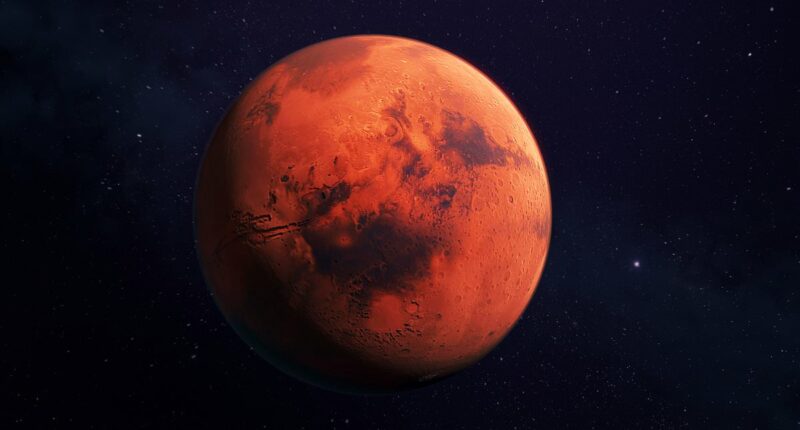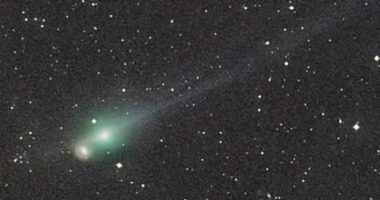Share this @internewscast.com
NASA’s Mars rover has discovered signs that the Red Planet went through several periods of flowing water, which may have created environments suitable for life.
Scientists have identified about 24 types of minerals, indicating that volcanic rocks in Jezero Crater interacted with liquid water in a dynamic history.
They said this indicated that Jezero hosted habitable environments on more than one occasion.
The water chemically transformed the rocks into salts and clay minerals, revealing three distinct episodes of fluid activity.
The first involved localized high-temperature acidic water, harsh and least favorable for life.
The second formed under moderate, neutral conditions, providing more hospitable environments over a larger area.
The third episode created widely distributed, low-temperature alkaline conditions, considered highly suitable for life.
Eleanor Moreland, a graduate student from Rice University who led the research, said, ‘The minerals discovered in Jezero suggest multiple, distinct episodes of fluid alteration over time.’
‘This reveals that there were numerous occasions in Mars’ history when volcanic rocks in the area came into contact with liquid water, offering more than one opportunity for life-friendly environments to develop.’

Scientists have found strong evidence that Mars was inhabited multiple times
The Jezero Crater, a 28-mile-wide zone on Mars, has been examined by NASA’s Perseverance rover since it landed in February 2021 to search for evidence of ancient life.
The rover’s findings confirm that the crater once hosted an old lake and river delta, with notable discoveries including unusual rock formations and organic molecules.
The latest research suggests that conditions suitable for life may have occurred multiple times throughout Mars’ history.
To interpret the rover’s data, the team used the Mineral Identification by Stoichiometry (MIST) algorithm alongside the Planetary Instrument for X-ray Lithochemistry (PIXL).
This tool identifies minerals in chemical data by comparing measurements to a database of known minerals.
The first group of minerals, greenalite, hisingerite, and ferroaluminoceladonite, formed in hot, acidic water confined to the crater floor.
Greenalite is an iron-rich mineral that forms in high-temperature, low-pH environments. Hisingerite is a clay-like mineral created when volcanic rocks react with acidic water.
Ferroaluminoceladonite is a more complex mineral that develops in volcanic rocks exposed to hot, acidic fluids.

The Perseverance rover discovered two dozen types of minerals that show a dynamic history of volcanic rocks altered by interactions with liquid water in the Jezero Crater
These rocks are among the oldest analyzed in the study, and their formation in extreme conditions would have made them least favorable for life, since high temperatures and acidity can damage biological structures.
Co-author Kirsten Siebach, assistant professor of Earth sciences, said: ‘These hot, acidic conditions would be the most challenging for life. But on Earth, life can persist even in extreme environments like the acidic pools of Yellowstone, so it doesn’t rule out habitability.’
The second group of minerals formed in moderate, near-neutral water, creating more favorable conditions for life and covering a larger area of the crater.
Minnesotaite, a clay-like mineral, was found on both the crater floor and the upper fan region, while clinoptilolite, a zeolite mineral, appeared only on the crater floor.
The third group formed under low-temperature, alkaline conditions, considered highly habitable from an Earth perspective.
Sepiolite, a common alteration mineral on Earth, formed under moderate temperatures and alkaline conditions and was widely distributed across all explored areas.
Its presence indicates a widespread episode of liquid water creating habitable conditions and infilling sediments across Jezero Crater.
‘These minerals tell us that Jezero experienced a shift from harsher, hot, acidic fluids to more neutral and alkaline ones over time, conditions we think of as increasingly supportive of life,’ Moreland said.
Because Mars samples cannot be prepared or scanned with the same precision as Earth rocks, the team created a model to account for uncertainties and strengthen their findings.
Using a statistical approach, MIST repeatedly tested mineral identifications while considering potential errors, similar to how meteorologists forecast hurricane paths by running multiple simulations.
‘Our error analysis lets us assign confidence levels to every mineral match,’ Moreland said.
‘MIST not only informs Mars 2020 science and decision-making, but it is also creating a mineralogical archive of Jezero Crater that will be invaluable if samples are returned to Earth.’
The findings confirm that Jezero, once the site of an ancient lake, experienced a complex and dynamic history of water activity.
Each new mineral discovery not only brings scientists closer to understanding whether Mars ever supported life but also guides Perseverance in selecting which samples to collect for potential return to Earth.
















